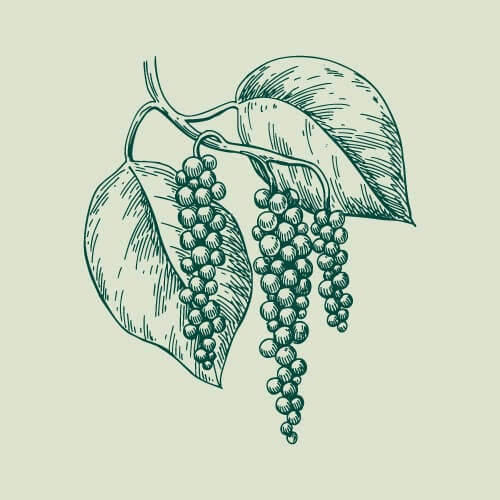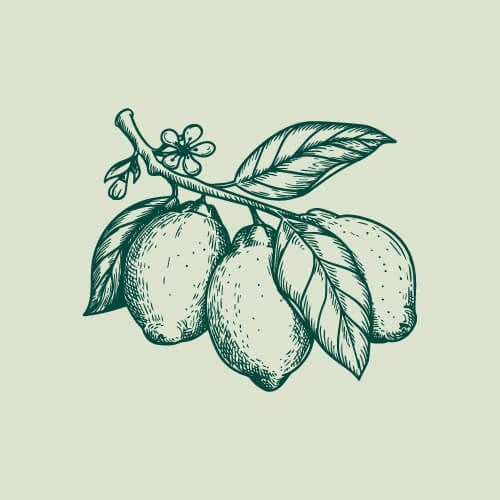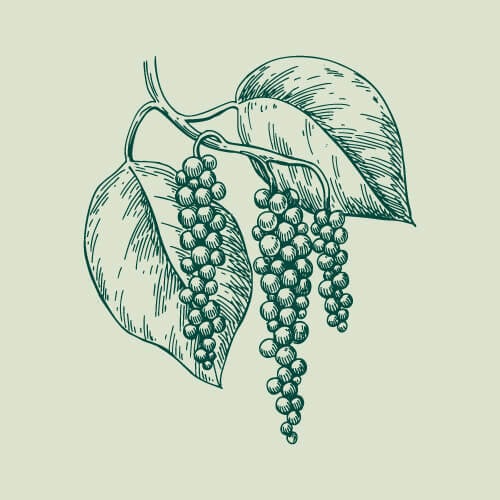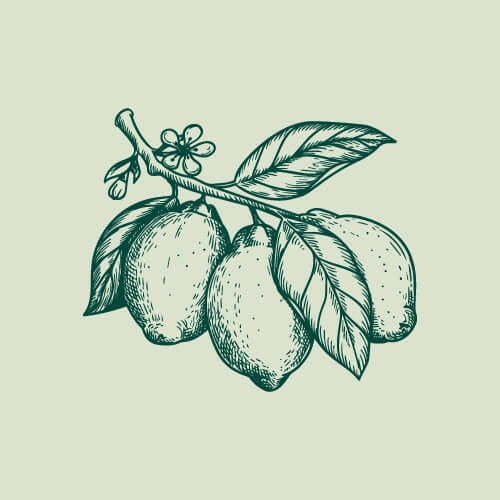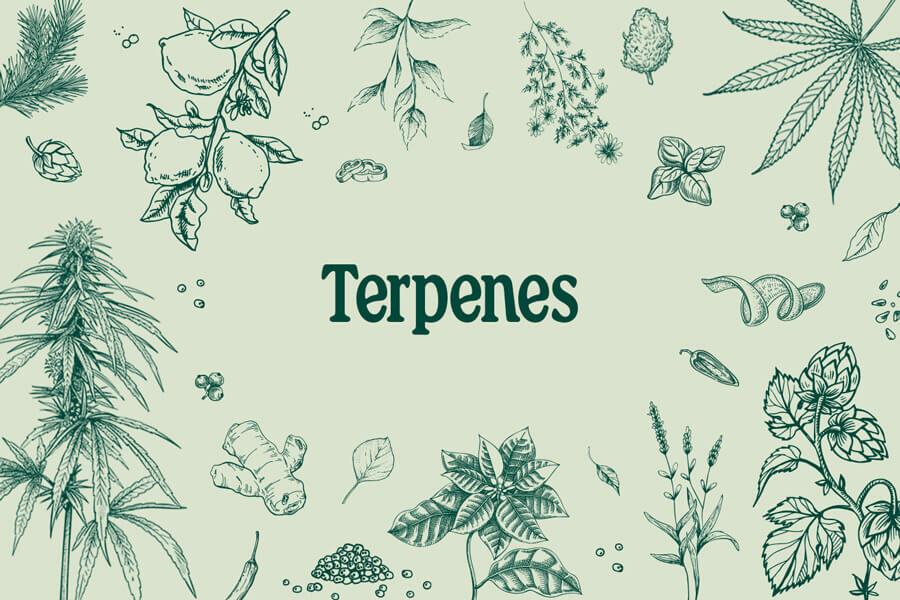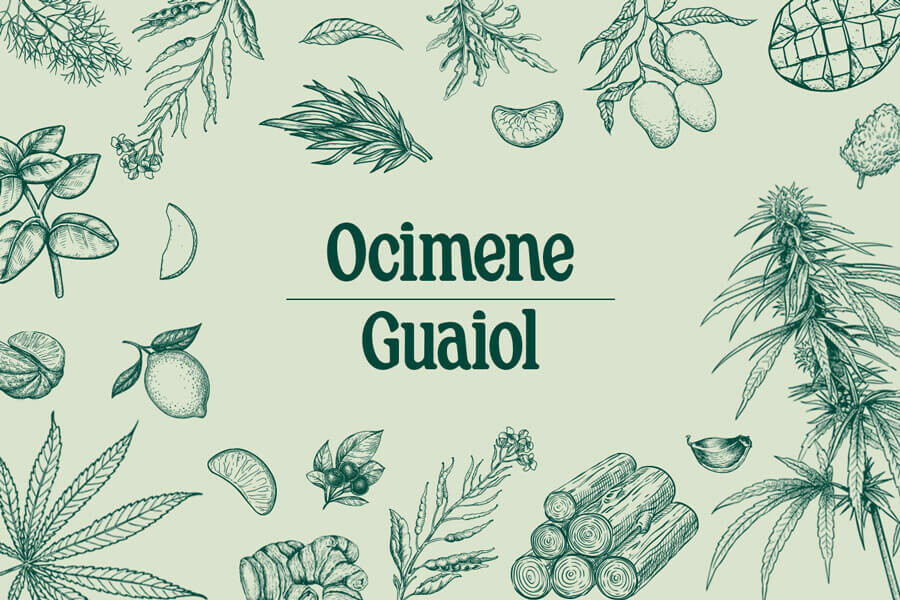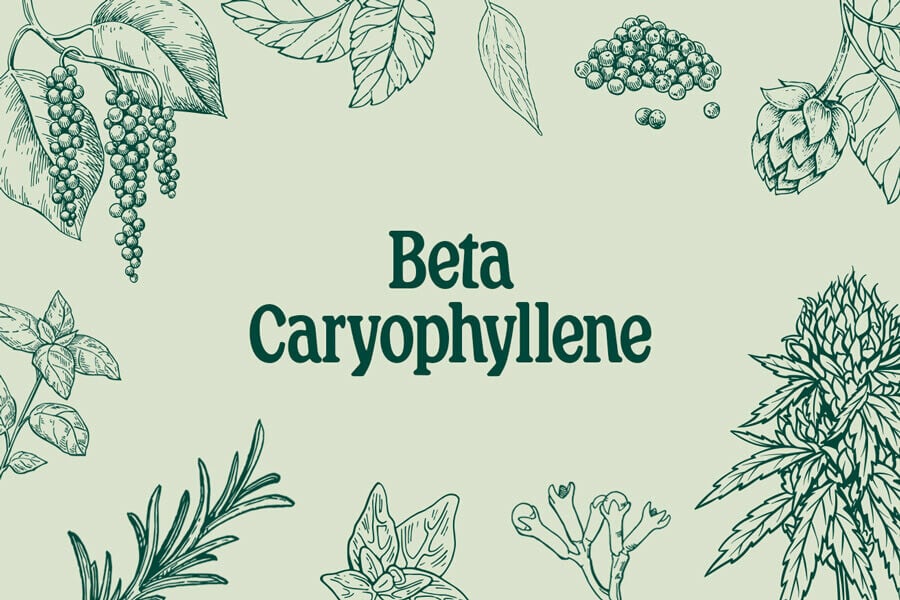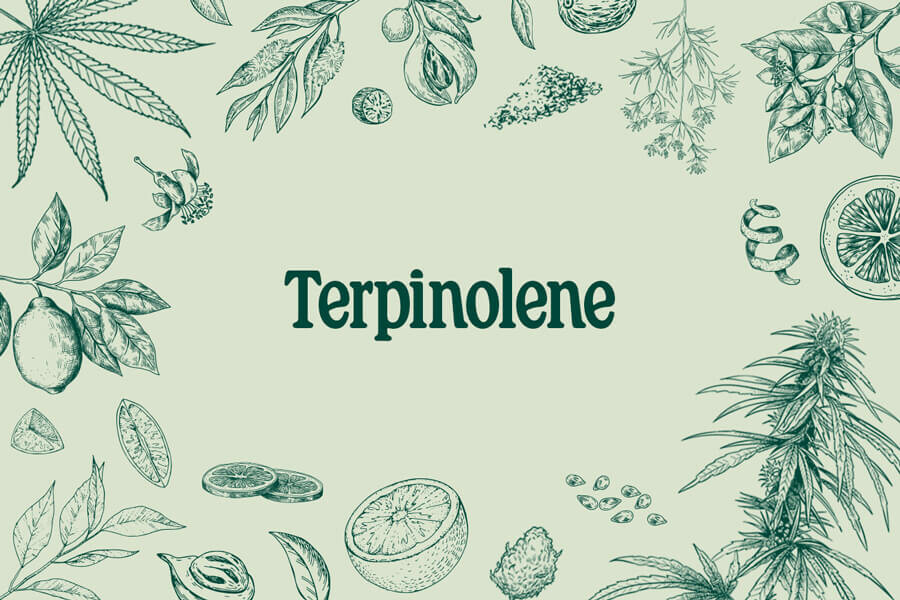.
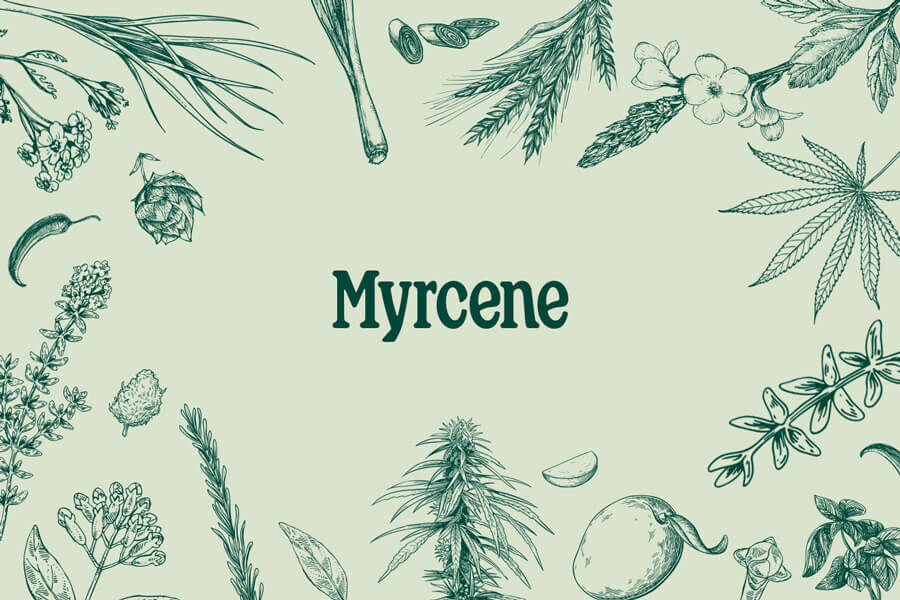
Myrcene: A Stoning Terpene With Big Potential
If you use cannabis, you've experienced the effects of myrcene before. Whether you knew it at the time or not, this terpene underpins the stoning sensation of many weed varieties, and also adds aromas of musk, fruit, and spice. Currently, researchers are exploring the therapeutic potential of this compound. Find out what we know so far.
Contents:
Terpenes are small, volatile aromatic compounds that play a fundamental role in the flavor, aroma, and effects of each cannabis variety. However, they’re not exclusive to your favorite herb. These molecules compose the largest and most diverse group[1] of naturally occurring compounds. They show up everywhere in nature, from orange peels and pine trees to herbs such as rosemary and sage. Cannabis plants themselves produce around 150 different terpenes. Among them, myrcene ranks as one of the most abundant. This fascinating chemical not only adds a stoning effect and tastes of musk and fruit to select cultivars, but ongoing research continues to determine its therapeutic potential. Discover everything worth knowing about myrcene below!

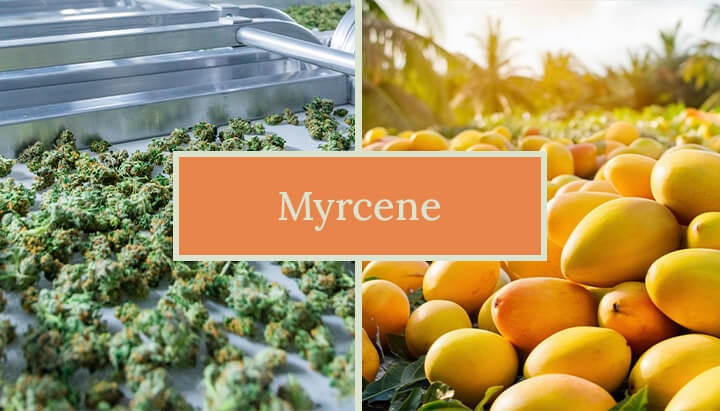
The Chemistry of Myrcene
You can view each terpene as a puzzle made up of smaller individual pieces called isoprene units—i.e. five-carbon hydrocarbon chains. Terpenes are categorised into several different groups based on how many of these hydrocarbon building blocks they possess. As the smallest type of cannabis terpene, myrcene contains only two isoprene units and therefore a total of ten carbon atoms. This structure places myrcene in the chemical group of monoterpenes, alongside the likes of limonene, terpinolene, linalool, and pinene. These simple molecules are among the most dominant[2] terpenes in the majority of cannabis varieties.
With a molecular weight of 136.23 g/mol, myrcene is volatile in nature, meaning it can easily evaporate at room temperature. Therefore, strains containing high levels of this compound are particularly aromatic during the flowering phase. It’s important to note that myrcene occurs as two different isomers: α-myrcene and β-myrcene. These two compounds share the same molecular formula in different structural arrangements. Of the two, β-myrcene is associated with the “couch-lock” effect of many different weed strains.
Myrcene and the Entourage Effect
In the past, cannabinoids such as THC and CBD were viewed as the sole drivers of the effects of each cannabis strain. On top of this, the indica/sativa dichotomy was believed to dictate whether a certain strain would cause users to feel energised or stoned. Advances in cannabis science have since debunked these myths. The modern concept of chemovars and chemotypes instead classifies the effects of cannabis varieties based on their cannabinoid and terpene contents.
Furthermore, the entourage effect hypothesis suggests that terpenes play a fundamental role in steering the effects of each chemovar, and may work in synergy with cannabinoids to amplify their effects.
While terpenes such as humulene and limonene directly activate[3] the endocannabinoid system—the network triggered by THC and other cannabinoids—myrcene works in a different way.
Research conducted at the University of Otago, New Zealand tested a range of cannabis terpenes[4] to see if they managed to activate the endocannabinoid system. Here, myrcene failed to show activity at both the CB1 and CB2 receptors, suggesting a lack of synergy. Another study[5], carried out at Dalhousie University, Canada, looked for evidence of the entourage effect in myrcene by administering the molecule alongside CBD in a mouse model of chronic arthritis. While the researchers detected reductions in markers associated with pain and inflammation, they found no evidence of a synergistic effect.
While myrcene doesn’t, as far as we know, influence the classical endocannabinoid system, it could work side by side with cannabinoids in more indirect ways. For example, the terpene works on the a2-adrenergic receptor, a site associated[6] with endocannabinoid system function in the brain. By binding to this receptor, myrcene stimulates the release of endorphins, which could work alongside cannabinoids such as THC when it comes to addressing pain.
Furthermore, myrcene also impacts the expanded endocannabinoid system. While CB1 and CB2 receptors make up the classical endocannabinoid system, the much larger endocannabinoidome[7] features around 20 receptors. Of these, myrcene binds to the TRPV1 receptor, as do the cannabinoids CBD and CBG. This activity opens up the possibility of synergistic action with these compounds and other cannabinoids and terpenes.
Where to Find Myrcene
Myrcene doesn’t only occur in cannabis flowers. This terpene shows up all across the plant kingdom, including in some of the most commonly consumed herbs, fruits, and spices. Species with notably high levels of myrcene include hops, lemongrass, mango, thyme, basil, and verbena. In cannabis, myrcene manufacturing occurs in the trichome glands, which secrete the terpene in the form of a viscous resin along with many other terpenes and cannabinoids.
Aroma & Flavor of Myrcene
Myrcene adds delightful aromas to select cannabis strains. Late in the flowering stage, and post-harvest, you’ll detect scents of musk, earth, fruit, and hints of cloves from these buds. When it comes to the myrcene terpene’s flavor, you’ll savour notes of musk, herbs, and spice every time you take a hit from a strain high in this compound.
Effects of Myrcene
Myrcene effects are best described as stoning. Traditionally, the relaxing, soothing nature of this terpene was erroneously credited to a strain’s indica heritage. Myrcene-rich varieties produce a heavy physical effect that reddens the eyes and triggers the munchies. But how exactly does the terpene produce this effect?
Well, researchers are still determining exactly how myrcene works in the body. While most of the evidence comes from cell and animal models, these studies offer insight into how myrcene could impact humans. A study[8] published in the journal Phytomedicine, for instance, looked at the relaxing effects of a number of terpenes present in Lippia alba essential oil, including myrcene. The researchers found that doses of 100 mg/kg of body weight and 200 mg/kg of body weight induced motor relaxant effects while also increasing sleeping time while under the influence of barbiturates.
While these effects were observed in rodents and not humans, they do correlate to the anecdotal accounts of cannabis users who report deep physical relaxation after using strains high in myrcene.
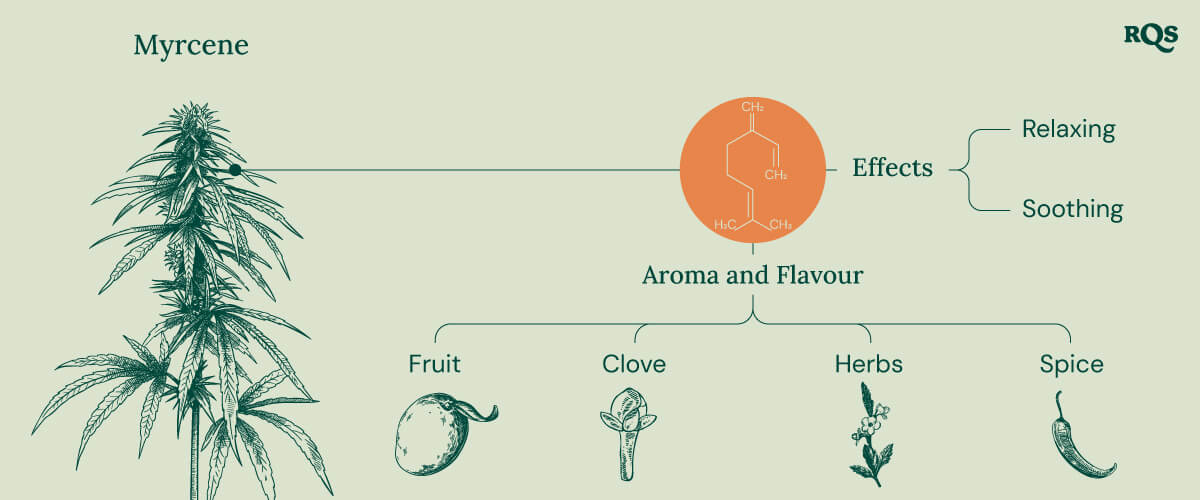
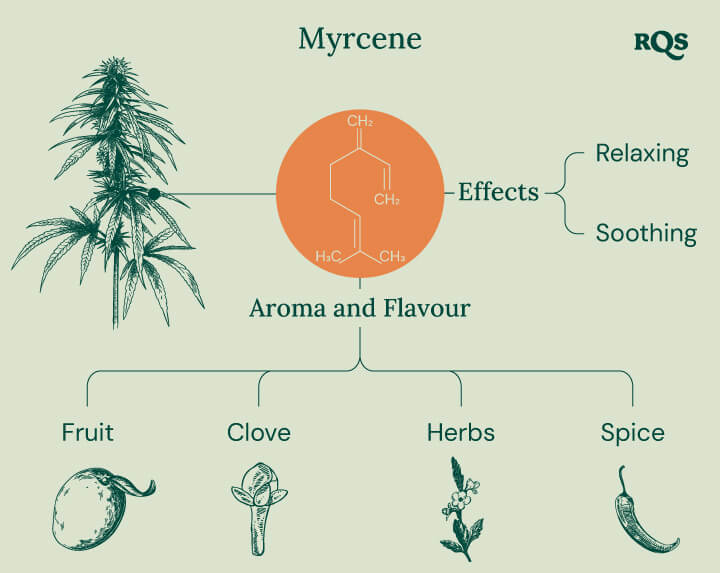
Myrcene: A Look at the Research
Now, let’s take a deeper look at the available research surrounding this terpene and its therapeutic potential. Though very preliminary, these cell and animal studies, and in some cases early human trials, offer a glimpse into what larger human studies could uncover in the future. Check out what we know so far.
-
Stress & Anxiety
A preliminary human study[9] published in Evidence-Based Complementary & Alternative Medicine observed the effects of myrcene-rich cannabis essential oil (EO) on the brain and autonomic nervous system (ANS). Using electroencephalography (EEG), the research team measured the brain activity of five healthy volunteers after using the oil. The team concluded: “These results suggest that the brain wave activity and ANS are affected by the inhalation of EO of Cannabis sativa suggesting a neuromodular activity in cases of stress, depression, and anxiety”.
-
Epilepsy
A study[10] conducted at the Federal University of Ceará, Brazil tested beta-myrcene and other Lippia alba essential oil components in an epilepsy model in mice. The team found that varying doses of myrcene delayed the onset of seizures and also increased the survival rate of mice after convulsions occurred. The researchers state that myrcene and other constituents “presented significant increases in the latency of convulsion and percentage of survival as compared to controls”.
-
Antibacterial
Scientists are currently evaluating terpenes[11] as a possible means of combating antibiotic-resistant infections. Out of all of the bacteria that infect humans, Staphylococcus aureus is particularly notorious for its ability to resist otherwise effective antibiotics. For this reason, researchers from Showa Pharmaceutical University, Japan pitted myrcene against this threatening microbe. The team concluded that “Myrcene acts as an antibacterial agent against S. aureus and is an important contributor to the antibacterial activity of TTO [tea tree oil]”.
-
Antioxidant
Myrcene may also display antioxidant activity—i.e. it may counter oxidative stress, signs of ageing, and degenerative diseases. A study[12] published in the journal Aquaculture administered myrcene to carp fish exposed to ammonia. The researchers reported that “Myrcene at 0.25–1% and menthol at 0.25% improved basal antioxidant, haematological and enzymatic responses”. Another study[13], published in the journal Chemico-Biological Interactions, found myrcene to induce antioxidant enzyme activity in experimental models of peptic ulcers.
Researchers from Argentina also believe that hops essential oil could serve as a natural replacement for synthetic antioxidants. The presence of both myrcene and caryophyllene showed good results in accelerated oxidation tests when applied together[14].
-
Pain & Inflammation
The benefits of the myrcene terpene could also span into the domain of pain and inflammation. A 2021 review[15] in Pharmacological Reviews reports that myrcene exhibits antinociceptive, antiallodynic, and anti-hyperalgesic properties. These terms refer to an ability to reduce the sensation of pain, an ability to lessen pain induced by normally non-painful stimuli, and an ability to reduce pain sensitivity, respectively.
Scientists are also assessing the potential of myrcene to quell inflammation. A study[16] published in the journal Molecules assessed beta-myrcene’s influence on signalling pathways linked to colon inflammation. More specifically, the team targeted MAP kinase pathways that are involved in the regulation of proinflammatory responses and NF-κB pathways that regulate genetics involved in the inflammatory response.
-
Anticancer
Researchers are also looking at the benefits of myrcene regarding cancer. A 2023 study tested several different terpenes using cytotoxicity, cell proliferation, cell migration, and morphology assays. Out of the four terpenes tested, only myrcene demonstrated “potential biological activity”.
Against cancer cell lines in the context of this study[17], myrcene “...leads to an arrest of proliferation, a decrease in motility and morphological changes with loss of sphericity and thickness, and DNA damage”.
Myrcene: A Stoning Cannabis Terpene With Big Potential
If you’ve ever smoked weed, you’ve felt the effects of myrcene. This small and volatile monoterpene packs a big punch and endows certain cannabis varieties with physically stoning effects and flavors/aromas of musk, fruit, and spice. Ongoing studies continue to explore the benefits of myrcene, with a particular focus on pain, inflammation, cancer, epilepsy, antibiotic resistance, antioxidant action, and stress and anxiety. While promising, we'll have to wait for the results of controlled human trials before we can truly know how this fascinating compound works in the human body.
- Therapeutic and Medicinal Uses of Terpenes https://www.ncbi.nlm.nih.gov
- Secondary Terpenes in Cannabis sativa https://www.mdpi.com
- Cannabis sativa terpenes are cannabimimetic and selectively enhance cannabinoid activity https://www.nature.com
- Terpenoids From Cannabis Do Not Mediate an Entourage Effect https://pubmed.ncbi.nlm.nih.gov
- Anti-Inflammatory and Analgesic Properties of the Cannabis Terpene Myrcene https://www.mdpi.com
- Cannabinoid modulation of alpha2 adrenergic receptor https://www.ncbi.nlm.nih.gov
- Overview of the Endocannabinoid System and Endocannabinoidome https://link.springer.com
- https://www.sciencedirect.com/science/article/abs/pii/S0944711304701786?via=ihub
- Cannabis Essential Oil: A Preliminary Study for the Evaluation of the Brain Effects https://pubmed.ncbi.nlm.nih.gov
- Anticonvulsant activity of essential oils and active principles from chemotypes https://pubmed.ncbi.nlm.nih.gov
- The Revaluation of Plant-Derived Terpenes to Fight Antibiotic-Resistant Infections https://www.mdpi.com
- Antioxidant, enzymatic and hematological responses of common carp https://www.sciencedirect.com
- The effect of a minor constituent of essential oil from Citrus aurantium https://pubmed.ncbi.nlm.nih.gov
- Antioxidant-efficient indicator determinate by the relationship between β-myrcene/caryophyllene https://www.sciencedirect.com
- Analgesic Potential of Terpenes Derived from Cannabis sativa https://pharmrev.aspetjournals.org
- β-Myrcene Mitigates Colon Inflammation by Inhibiting MAP Kinase and NF-κB Signaling Pathways https://pubmed.ncbi.nlm.nih.gov
- Myrcene: A Natural Compound Showing Anticancer Activity in HeLa Cells https://pubmed.ncbi.nlm.nih.gov




























